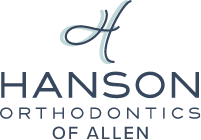Common Orthodontic Issues – Allen, TX
When Should You Seek Professional Care?

Our orthodontist is an expert at diagnosing common orthodontic issues in Allen. If you suspect that your dental alignment — or that of your child — is not quite right, visit us for a checkup. After we evaluate the positioning of your teeth, we will design a treatment plan to help you gain a healthier, more attractive smile. In the meantime, continue reading this page to learn the basics about orthodontic problems that we often treat at Hanson Orthodontics of Allen.
Overcrowding

When the teeth are positioned too close to each other, or even overlapping, this poses a significant problem. The teeth may trap food between them, and thorough brushing and flossing can be a challenge. You may therefore be at a heightened risk of tooth decay and gum disease. The good news is that braces in Allen — or another type of orthodontic treatment — can shift the teeth so they each have the space they need to function optimally. To learn more about overcrowding, continue reading!
What Is Dental Crowding?

If your teeth are competing for space in your mouth and have grown in improperly, you may suffer from dental crowding. It’s a common issue that occurs when your pearly whites don’t erupt correctly, causing them to be twisted and misaligned. Treating crowding is incredibly important to prevent oral health problems like tooth decay. You can easily address it with effective, supervised orthodontic care.
What Causes Dental Crowding?

There are many factors that can lead to overcrowding, such as:
- Losing baby teeth prematurely
- Extra adult teeth
- Abnormal tooth growth
- Unusually large teeth, which can be the result of certain syndromes
One of the most common reasons for dental crowding is genetics. If you inherit a small jaw, it can affect the way your teeth grow in, causing overcrowding.
What Are the Signs of Dental Crowding?

Not sure if you or your child’s teeth are crowded? There are multiple signs you can look for that indicate your teeth are crowded, including:
- Discomfort on tooth when biting
- Crooked teeth set at unnatural angles in your mouth
- Teeth overlapping
- Crossbite
- Excessive overjet
- Jaw pain
- Difficulty biting or chewing
- Trouble brushing and flossing
- Bleeding gums when flossing
Is Crowding Bad for Your Teeth?

Absolutely! It’s crucial that you address overcrowding because it can cause lasting problems for your teeth, gums, mouth, and overall health. The biggest problem with dental crowding is that can lead to poor oral hygiene, mainly because it’s much harder to clean your teeth properly. Failing to keep your mouth clean will lead to bacterial growth and plaque build-up.
To avoid these issues, the American Association of Orthodontists recommends bringing children to see an orthodontist beginning at age 7. While children may not begin treatment immediately, the orthodontist will be able to monitor and predict the growth pattern of teeth. If necessary, they will make an intervention plan to prevent dental crowding in the first place.
How Is Dental Crowding Treated?

As mentioned earlier, dental crowding can lead to several issues if left untreated. Fortunately, licensed orthodontists are able to correct crowded teeth using various different methods.
Some common treatment options are:
- Braces – Metal, ceramic, or lingual braces can all help properly straighten teeth.
- Invisalign – Using a series of clear aligners, Invisalign is an extremely effective way to address crowding.
- Extractions– If teeth are extremely overcrowded, it may be necessary to have certain ones extracted.
Gapped Teeth

During childhood, extra space between the teeth may seem cute and endearing, and it is true that not all cases of gapped teeth require treatment by an “orthodontist near me.” However, if you want to close gaps between your teeth for aesthetic reasons, we are ready to help. Eliminating extra space may also benefit your oral health by protecting your gums, preventing them from accumulating bacteria that can lead to infections and disease.
Overbite

An overbite occurs when the top teeth rest farther forward than your bottom teeth while your mouth is closed. Everyone has a slight overbite, but when the space between the two rows of teeth is significant, problems can result. For example, your tooth enamel may be more prone to wear and tear. Your facial aesthetics may also be adversely affected. Your orthodontist can provide treatment that realigns your teeth and jaws to create a more harmonious bite.
Underbite

An underbite is the opposite of an overbite. It occurs when the bottom teeth stick our farther than the top teeth. This issue, caused by a forward resting position of the lower jaw, can lead to problems with the TMJ (jaw joint). It can also affect facial aesthetics and cause premature wear and tear on your smile. Orthodontic treatment can realign the teeth and train the lower jaw to rest in its proper place, lowering your risk of oral health problems and providing you with a more beautiful smile.
Crossbite

A crossbite is an issue that happens when some of your upper teeth, but not all of them, rest behind your lower teeth. This problem should receive treatment sooner rather than later; a bite issue of this sort can place extra pressure on certain areas of the mouth, leading to facial asymmetry and a number of oral health problems. Orthodontia provided by Dr. Hanson can address a crossbite so you can enjoy an optimally functional smile.
Open Bite

An open bite happens when the back teeth contact one another, but the front teeth do not. It is often caused by excessive thumb-sucking during childhood or other myofunctional problems. If you notice that your child may be developing this issue, bring them in for an evaluation as soon as possible. Early intervention may help them to avoid complex and extensive orthodontic care down the road.

